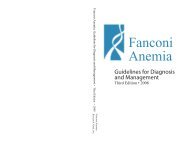FA Family News 3/01 - Fanconi Anemia Research Fund
FA Family News 3/01 - Fanconi Anemia Research Fund
FA Family News 3/01 - Fanconi Anemia Research Fund
Create successful ePaper yourself
Turn your PDF publications into a flip-book with our unique Google optimized e-Paper software.
Comparison Between Complementation Group<br />
and Mutations, and Clinical Outcomes<br />
Christopher Mathew, PhD, Guy’s<br />
Hospital, London, and collaborators<br />
published an article in Blood, December<br />
15, 2000, on the association<br />
between complementation group and<br />
mutation type and the clinical outcome<br />
in <strong>Fanconi</strong> anemia. The authors<br />
studied 245 patients from all known<br />
complementation groups. Disease<br />
mutations were identified in 169<br />
patients. The authors noted that <strong>FA</strong>-<br />
G patients had severe bone marrow<br />
failure and a higher incidence of<br />
leukemia. Birth defects or anomalies<br />
were more common in the rare groups<br />
<strong>FA</strong>-D, <strong>FA</strong>-E, and <strong>FA</strong>-F. In <strong>FA</strong>-A,<br />
patients who inherited mutations from<br />
both parents which knocked out protein<br />
production from the <strong>FA</strong>NCA gene<br />
had an earlier onset of anemia and a<br />
higher incidence of leukemia than<br />
those with mutations producing an<br />
altered protein. In <strong>FA</strong>-C, there was a<br />
later age of onset of aplastic anemia<br />
and fewer birth defects in patients with<br />
the 322delG mutation; there were<br />
more anomalies in patients with the<br />
IVS-4 mutation. ◆<br />
Four Patients Transplanted with Related,<br />
Mismatched Donors Do Well<br />
Farid Boulad, MD, Memorial-<br />
Sloan Kettering, reports that he has<br />
now transplanted four <strong>FA</strong> patients<br />
using related, mismatched donors. Two<br />
were mismatched at two antigens; two<br />
were mismatched at one antigen. For<br />
the first patient, this was a second<br />
transplant; for the subsequent three<br />
patients, it was a first transplant. Dates<br />
of transplant were 5/27/98, 3/31/99,<br />
1/20/00, and 10/26/00. Except for the<br />
patient receiving a second transplant,<br />
patients received total body irradiation.<br />
Protocols included fludarabine<br />
and cyclophosphamide. Three patients<br />
received G-CSF-mobilized peripheral<br />
blood stem cells and one patient bone<br />
marrow stem cells. All stem cells were<br />
T-cell depleted to prevent graft-versushost<br />
disease.<br />
All four patients engrafted early<br />
(between days nine and eleven posttransplant).<br />
Immune reconstitution<br />
occurred at 8 months for the first two<br />
and 12 months for the third. It is too<br />
soon to evaluate the fourth patient. All<br />
four are alive and well; the first three<br />
patients are alive almost three years,<br />
two years and one year post-transplant.<br />
No patient has yet experienced acute or<br />
chronic graft-versus-host disease. The<br />
third patient had post-transplant complications<br />
(CMV infection and EBV<br />
lymphoma) which have been resolved.<br />
The number transplanted is very small<br />
and the time, post-transplant, for the<br />
fourth patient is inadequate for a full<br />
evaluation. Nevertheless, Boulad is<br />
optimistic about these very promising<br />
results. ◆<br />
We will perform complementation<br />
group testing on peripheral blood and<br />
bone marrow aspirate samples. Patients,<br />
through their own physicians, can send<br />
bone marrow aspirate and blood samples<br />
to my lab (see address below).<br />
Samples can be sent at room temperature<br />
and should contain anticoagulant<br />
such as EDTA for overnight shipment.<br />
Notification of the lab 1-2 days<br />
before shipment would be appreciated.<br />
There is no cost to families.<br />
Helmut Hanenberg, MD,<br />
Will Do Complementation<br />
Analysis for <strong>FA</strong><br />
Families<br />
Helmut Hanenberg will do complementation<br />
analysis for all known<br />
complementation groups. Peripheral<br />
blood is the easiest and quickest material<br />
to analyze, although he can use any<br />
cell type that can be grown in culture.<br />
Hanenberg recommends sending 8 -<br />
12 mls of blood because of the long<br />
distance from the United States to Germany.<br />
There is a likelihood of greater<br />
than 95 percent of finding the defective<br />
gene using his method. At the present<br />
time, there is no cost for this service.<br />
For information on shipping and<br />
handling, contact:<br />
Dr. Helmut Hanenberg<br />
Department of Pediatric<br />
Hematology & Oncology,<br />
Children’s Hospital,<br />
Heinrich Heine University<br />
Moorenstr. 5<br />
40225 Duesseldorf, Germany<br />
e-mail: Helmut.Hanenberg@uniduesseldorf.de<br />
phone: <strong>01</strong>1 49 211 811-6103<br />
fax: <strong>01</strong>1 49 211 811-6436<br />
Chapel Hill, NC Will Perform Complementation<br />
Group Testing on <strong>FA</strong> Families<br />
by Chris Walsh, MD<br />
In addition, if patients are undergoing<br />
tumor biopsy or surgical excision,<br />
those samples can also be sent to<br />
the following address:<br />
Dr. Chris Walsh<br />
Rm. 71<strong>01</strong> Thurston Bldg.<br />
CB#7352<br />
Chapel Hill, NC 27599<br />
phone: 919-966-9116<br />
fax: 919-966-0907<br />
e-mail: cwalsh@med.unc.edu<br />
Spring 20<strong>01</strong> 3

















